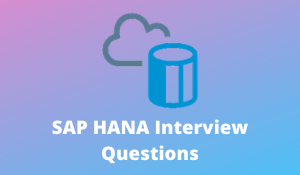
Mention what is SAP HANA?
SAP HANA stands for High-Performance Analytical Appliance- an in-memory computing engine. HANA is linked to ERP systems; a front-end modeling studio can be used for replication server management and load control.
Mention the two types of Relational Data stored in HANA?
The two types of relational data stored in HANA include
Row Store
Column Store
Mention what is the role of the persistence layer in SAP HANA?
SAP HANA has an in-memory computing engine and accesses the data straightaway without any backup. To avoid the risk of losing data in case of hardware failure or power cutoff, the persistence layer comes as a savior and stores all the data in the hard drive which is not volatile.
Mention what is modeling studio?
Modeling studio in HANA performs multiple tasks like
Declares which tables are stored in HANA, the first part is to get the meta-data and then schedule data replication jobs
Manage Data Services to enter the data from SAP Business Warehouse and other systems
Manage ERP instances connection, the current release does not support connecting to several ERP instances
Use data services for the modeling
Do modeling in HANA itself
essential licenses for SAP BO data services
Mention what are the different compression techniques?
There are three different compression techniques
Run-length encoding
Cluster encoding
Dictionary encoding
Which companies are providing SAP HANA hardware appliances?
There are a total of 11 vendors for SAP HANA hardware appliances. Most common are −
Dell
IBM
HP
Cisco
Lenovo
What are the different license key types in the HANA system?
Temporary License key
Permanent License Key
What is latency?
Latency refers to the length of time to replicate data from the source system to the target system.
Write about the types of packages in HANA.
There are two types of packages in HANA Structural package and Non-structural package.
The structural package has sub-packages but not repository objects whereas the Non-structural package contains both sub-packages and repository objects.
Describe column-based and row-based approaches?
Column column-based approach is a sequential database approach. Tables are stored in a sequence of columns here
Row row-based approach is a traditional relational database approach that is followed. It uses a sequence of rows to store tables.
11) What is the language used to develop the SAP HANA program and mention the operating system supported by SAP HANA?
The SAP HANA database is developed using C++ and at present, the operating system supported by SAP HANA is SUSE Linux Enterprise Server x86-64 (SLES) 11 SP
Mention the role of master controller job in SAP HANA?
The job is arranged on demand and is responsible for
Creating database triggers and logging tables into the source system
Creating Synonyms
Writing new entries in admin tables in the SLT server when a table is replicated/loaded
Explain how SQL statement is processed?
In the HANA database, each SQL statement is implemented in the reference of the transaction. A new session is allotted to a new transaction.
| Learn more information from the GoLogica “SAP ABAP Training“ |
Explain how you can avoid unnecessary information from being stored?
To avoid unnecessary information from being stored, you have to pause the
replication by stopping the schema-related jobs.
Mention the role of the master controller job in SAP HANA?
The job is arranged on demand and is responsible for
Creating database triggers and logging tables into the source system
Creating Synonyms
Writing new entries in admin tables in the SLT server when a table is replicated/loaded
Explain what happens if the replication is suspended for a longer period or system outage of the SLT or HANA system?
If the replication is suspended for a longer period, the size of the
logging tables increases.
What is the language SAP HANA is developed in?
The SAP HANA database is developed in C++.
What is the purpose of a master job?
Every 5 seconds, the monitoring job checks in the SAP HANA system whether there are new tasks and, if so, triggers the master control jobs. It also deletes the processed entries (tasks) from table RS_ORDER and writes statistics entries into table RS_STATUS
What is the purpose of the Migration Object Definition Job?
This job defines the migration object of a specific table, which is the fundamental object for LT replication. The migration object definition should normally be quite fast for all tables.
What is SLT?
SLT stands for SAP Landscape Transformation which is a trigger-based replication. SLT replication server is the replication technology to pass data from the source system to the target system. The source can be either SAP or non-SAP. The target system is the SAP HANA system which contains the HANA database.
Related Articles:
🎯 SAP VC Tutorial
🎯 What Is SAP BPC 11.0?
🎯 Features And Functionality – SAP BPC
🎯 Introduction To Financial Consolidation – SAP BPC
🎯 Crystal Reports Tutorial – GoLogica
🎯 A Complete Guide to SAP Variant Configuration
🎯 SAP BPC Tutorial for Beginners
🎯 SAP Simple Finance Interview Questions

